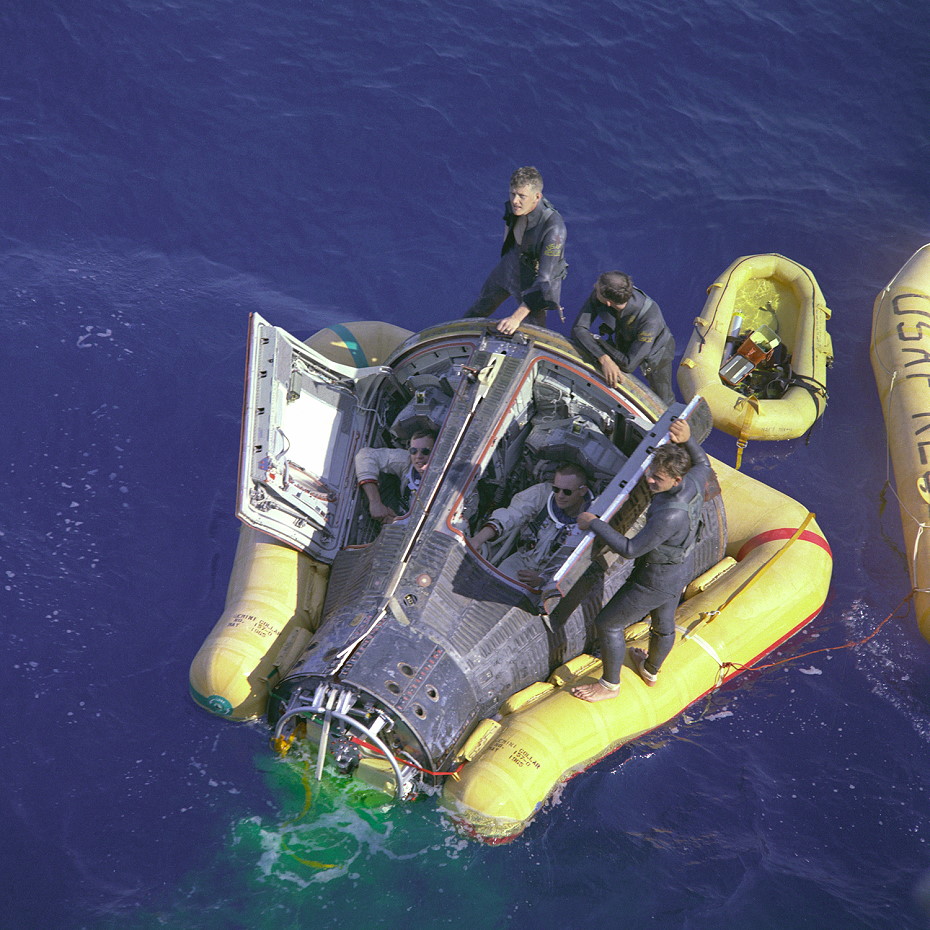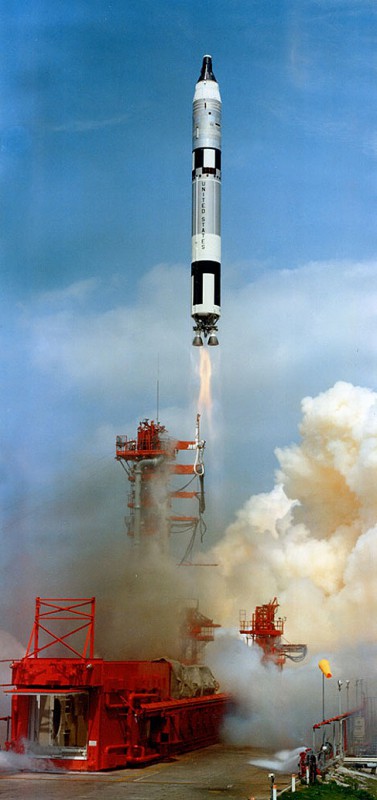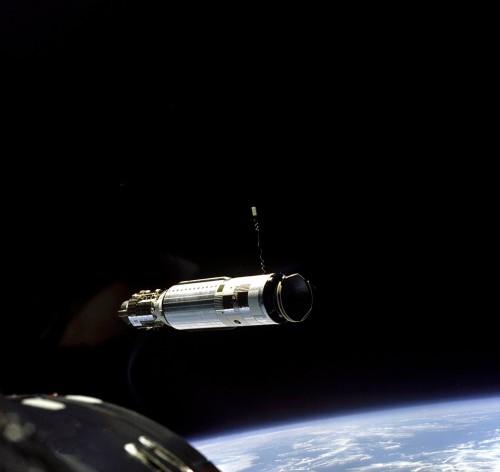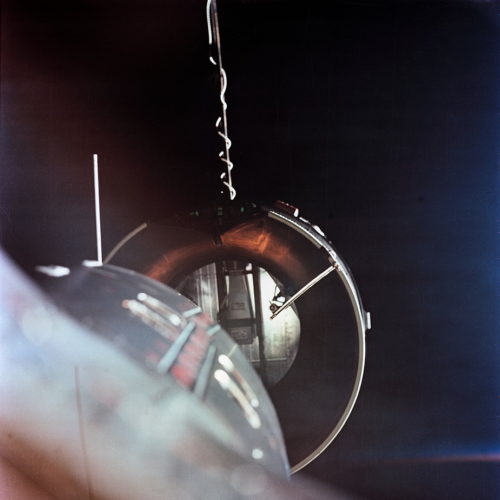
Forty-eight years ago today, Gemini VIII astronauts Neil Armstrong and Dave Scott accomplished a key goal in America’s bid to land a man on the Moon by successfully rendezvousing and docking with an unmanned Agena target vehicle in Earth orbit. As noted in yesterday’s AmericaSpace article, it was the first time that a manned vehicle had achieved physical contact with another target in space. However, the situation aboard Gemini VIII was far from perfect. A distinct lack of available tracking stations across the flight path had already resulted in decidedly “spotty” communications with the Mission Operations Control Room (MOCR) in Houston, Texas. In fact, only two ship-based stations were supporting the flight, the Rose Knot Victor and the Coastal Sentry Quebec, together with a land site in Hawaii. Shortly before one loss of contact, at around 6:35 p.m. EST on 16 March 1966, Capcom Jim Lovell radioed the Gemini VIII crew. If problems arose, he told them, they should immediately deactivate the Agena with Command 400 and assume manual control with the Gemini. It was a standard call. Lovell could hardly have imagined that a potential disaster would soon engulf the mission.
Half an hour after docking with the Agena, Dave Scott instructed the target to roll them 90 degrees, and Neil Armstrong, in the commander’s seat, told Lovell that it had “gone quite well.” The call came a few seconds before Gemini VIII passed out of radio contact with the ground. Alone, the astronauts electronically activated the Agena’s tape recorder. Shortly thereafter, their attitude indicator showed that they were in an unexpected, and almost imperceptible, roll of about 30 degrees. “Neil,” called Scott, “we’re in a bank.” Were the Agena’s attitude controls misbehaving? Or was it a problem with the target vehicle’s software? Certainly, Gemini VIII’s own thrusters were now switched off and the assumption could safely be made that the Agena was at fault. What they did not know was that one of their thrusters—the No. 8 thruster—had short-circuited and stuck into its “on” position. Unaware, Scott cut off the Agena’s thrusters, whilst Armstrong reactivated the Gemini’s thrusters in an attempt to stop the roll and bring the combination under control.
For a few minutes, his effort succeeded.

Gradually, the craft stabilized. Then, as Armstrong started to reorient them into their correct position, the unwanted motions resumed … albeit much faster than before and along all three axes. Perplexed, the men jiggled the Agena’s control switches, then those of the Gemini, on and off, in a fruitless attempt to isolate the problem. Glancing at his instrument panel, Scott noticed that their craft’s attitude propellant had dropped to just 30 percent. At this stage, it dawned on the astronauts that the fault was with their craft. “We had to disengage from the Agena,” Scott later wrote in his memoir, Two Sides of the Moon, “and quickly.”
This posed its own problems, since both craft were rapidly rotating and could hit each other. Quickly, Scott set the Agena’s recording devices to allow flight controllers to remotely command it; a crucial step, since, after undocking, the target would otherwise be dead. “No one would ever know what the problem had been or how to fix it,” he wrote. His prompt action saved the Agena and preserved it not only for subsequent investigations, but also for a remarkable “double rendezvous” on the Gemini X mission in July.
Armstrong and Scott were still out of radio communications with the ground. They duly undocked from the Agena and fired a long burst of the Gemini’s thrusters to pull away … whereupon their craft, now free, began to spin much more violently, in roll, pitch, and yaw axes. Since the stuck-on No. 8 thruster was no longer turning the entire combination, the oscillations were correspondingly worse than before. At length, high above southeast Asia, they came into contact with the Coastal Sentry Quebec. Controllers were stunned at 6:58 p.m. when Dave Scott’s urgent call came through.
“We have serious problems here,” he reported. “We’re tumbling, end over end. We’re disengaged from the Agena.”
Jim Fucci, the communicator aboard the ship, was stunned and asked them about the problem. Quickly, and characteristically calm, Armstrong reported that they were continuously increasing in a left roll and unable to turn anything off. Fucci, an old NASA hand with great experience, alerted Houston that Gemini VIII was suffering from “pretty violent oscillations.” The resultant three-way conversation with the MOCR meant that several seconds elapsed before Flight Director John Hodge picked up all the details; Fucci had to repeat that Armstrong was “in a roll and he can’t stop it.”
In orbit, Armstrong threw circuit breakers to cut electrical power and hence the flow of propellant to the attitude thrusters, including troublesome No. 8. However, with no friction or counter-firing thrusters to halt it, the spinning continued … reaching a horrifying 60 revolutions per minute. Checklists, flight plans, and procedural charts were flung around Gemini VIII’s cabin by the resultant centrifugal force, and the unfiltered sunlight blazed through the astronauts’ windows with startling regularity. To Dave Scott, it was like a constant strobe light, hitting them square in the face. Added to this, the rotation was such that the astronauts were close to physically blacking out and they struggled to read their instruments. Physiologically, Armstrong and Scott were suffering from a complete loss of orientation, caused by the effect on their inner ears, together with an involuntary rhythmic motion of their eyes.

Aware that the problem was with his own spacecraft, Armstrong had little choice but to use Gemini VIII’s 16 re-entry thrusters to steady them. This was easier said than done … for the re-entry controls were in a particularly awkward position, directly above his head, and, worse, they were on a panel with around a dozen toggles. “With our vision beginning to blur,” wrote Scott, “locating the right switch was not simple.” Fortunately, months of repetitive training had allowed the astronauts to know each switch, intuitively, but Scott was amazed at Armstrong’s flying skill as he reached for the toggle and grappled with the spacecraft’s hand controller, at the same time. Eventually, the effort succeeded, albeit at the expense of 75 percent of Gemini VIII’s propellant. Mission rules decreed that, once the re-entry controls had been activated, the flight was aborted. Ten hours into a planned three-day mission, Armstrong and Scott were on their way home.
Television stations began interrupting their programmes—Batman and, ironically, Lost in Space—to provide live coverage. Original plans had called for Gemini VIII to splash down in the Atlantic and be recovered by the aircraft carrier U.S.S. Boxer, but the emergency guided them instead to a point in the western Pacific, 500 miles (800 km) east of Okinawa. A naval destroyer, the U.S.S. Leonard F. Mason, based off the coast of Vietnam, was assigned to this splashdown zone and her crew began steaming toward the predicted point.
The bitterly disappointed astronauts ran through their pre-retrofire checklist, and tests of Gemini VIII’s thrusters finally identified the fault with No. 8. Scott later described the thrusters as not exhibiting “a consistent, linear problem … it was really screwed up.” In effect, the thruster had been “on” when it should have been “off” and vice versa. Loading the re-entry software into the spacecraft’s 4,000-word computer memory was difficult, particularly as it was already overloaded from the rendezvous with the Agena. This required Scott to erase the rendezvous and docking programs and feed the re-entry data by means of a keypad and auxiliary tape memory unit. Punching in a series of nine lines of seven-digit numbers, he checked and cross-checked his work with Jim Fucci, whose admirable calmness under duress made those critical moments seem like “taking a stroll in the park.”

At 9:45 p.m., Gemini VIII’s retrorockets fired above south-central Africa, in orbital darkness, which gave the astronauts no visual cues for alignment. The spacecraft re-entered over the high peaks of the Himalayas, and, as it descended, Scott could see nothing through his window, save a pinkish-orange glow of superheated plasma outside … then, after a while, came high-level haze and, later, the glint of water. Ten hours and 41 minutes after leaving Cape Kennedy—at 10:22 p.m. on 16 March in Florida, but a little after midday on 17 March in the western Pacific—Gemini VIII hit the choppy waters with a harsh thump. Seasickness was an inevitability as the spacecraft’s windows rhythmically rolled and pitched, but the men stepped smartly through the shutdown of electrical and other systems. They had forgotten to take their anti-seasickness pills. “When Mission Control told us about three-foot waves,” Scott recalled, “they forgot to mention the 20-foot swells!”
First on the scene were U.S. Air Force Pararescuemen (PJs) from 33 Air Rescue Service, scrambled out of Naha Air Force Base, Okinawa, aboard a Grumman HU-16 Albatross flying boat. They successfully parachuted into the Pacific Ocean, applied the capsule flotation collar to stabilize Gemini VIII and were first to tend to the immediate medical needs of Armstrong and Scott. They were followed, several hours later, by the arrival of the Mason. In fact, the destroyer’s crew had been less than enamored when they were assigned to be one of the backup recovery vessels. They had just finished a seven-week tour in Vietnam and had been given a brief spell of liberty in Okinawa. Now they were as relieved as the rest of the world that Armstrong and Scott were safe.
In the weeks that followed, post-flight analysis removed any blame from the shoulders of the astronauts. Still, astronauts Walt Cunningham and Tom Stafford expressed criticism; the former pointed to flaws in both Armstrong and Scott’s performance, and the latter argued that undocking from the Agena had been the wrong decision. Flight Director Gene Kranz, who supervised Gemini VIII’s re-entry, saw things differently. He regarded it as a failure of the ground controllers in having few contingency procedures to cover the docked phase of the mission. Other astronauts, including Frank Borman and Wally Schirra, praised the actions of the crew as having saved the mission from disaster. Without their safe return, the erroneous belief that the Agena was to blame could have diseased Project Gemini’s final months and made it difficult for Project Apollo—with its emphasis on rendezvous and docking—to move confidently ahead. In Scott’s words, it could have been “a showstopper.”
The performance of Neil Armstrong and Dave Scott in March 1966 was nothing short of remarkable. They had completed a flawless docking with the Agena and, but for the stuck-on No. 8 thruster, might have gone on to complete an equally flawless three-day mission. That neither man was to blame for the events of Gemini VIII is amply highlighted by their subsequent careers: Armstrong was reassigned as backup commander of Gemini XI, whilst Scott was named as senior pilot on the backup crew for the first manned Apollo mission. In time, they would venture further, becoming the only Gemini crew whose both members would someday set foot on the Moon.
The author would like to express grateful thanks to Mr. Jeff Morrisette (SGT USAF, CDR USN, Ret.) for his clarification and additional detail regarding the critical role of U.S. Air Force Pararescuemen (PJs) in the safe recovery of the Gemini VIII.
This is part of a series of history articles, which will appear each weekend, barring any major news stories. Next week’s article will focus on the flight of Gemini 3 in March 1965, the first piloted mission of Project Gemini … a voyage forever associated with the corned beef sandwich.
Want to keep up-to-date with all things space? Be sure to “Like” AmericaSpace on Facebook and follow us on Twitter: @AmericaSpace
Missions » Apollo » Missions » Apollo » Apollo 1 »



The Gemini VIII flight was a remarkable mission not only for the first docking in space but also for the demonstration of exceptional piloting skills by Armstrong and Scott. It provided valuable lessons for contingencies that were needed in Apollo 13.
Thanks again, Ben!
This is amazing – a collection of best pictures ever of Earth more 20 best pictures ever of Earth
Pictures: http://earthspacecircle.blogspot.com/p/best-pictures.html
From site: http://earthspacecircle.blogspot.com/
The current religion is that you don’t mix crew and cargo. But a big shuttle allows stability. The capsule spun worse when freed from the Agena. This is why it is so hard to get tiny landers and kinetic Kill vehicles to work–at a small scale, the computer can be faster than the plumbing.